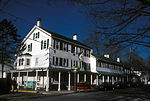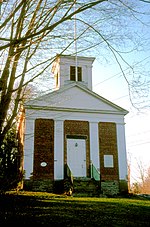Essex Reef Light
Connecticut RiverEssex, ConnecticutLighthouses completed in 1889Lighthouses in ConnecticutTransportation buildings and structures in Middlesex County, Connecticut
The Essex Reef Light or Essex Reef Post Light, also known as Hayden's Point Light, was a light in Essex, Connecticut on the Connecticut River. The 21-foot (6.4 m) wooden tower was erected in 1889 and replaced with a skeleton tower by 1919. The skeleton tower was further altered to an automatic gas light a few years prior to 1931. Its keeper, Gilbert Burnett "Bernie" Hayden served for 30 years. As of 2014, a 26-foot (7.9 m) skeleton tower serves as an active daymark and it has a green flash every 4 seconds.
Excerpt from the Wikipedia article Essex Reef Light (License: CC BY-SA 3.0, Authors).Essex Reef Light
Fordham Road,
Geographical coordinates (GPS) Address Nearby Places Show on map
Geographical coordinates (GPS)
| Latitude | Longitude |
|---|---|
| N 41.345166666667 ° | E -72.376722222222 ° |
Address
Fordham Road 38
06426
Connecticut, United States
Open on Google Maps









